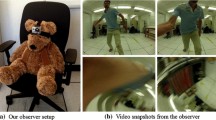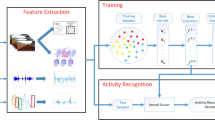Abstract
This paper presents human activity recognition problem from first-person view-point (ego-centric video). The task is to understand the activities of a person by an observer (wearable camera or robot) from real-time video data. An efficient human activity recognition system demands the choice of useful traits and the suitable kernels for those traits. In this work, we have proposed a combined kernel learning (CKL) framework using PSO as optimization algorithm for first-person activity recognition in a video. This framework does appropriate feature selection and combines those features from their respective kernels from the video data in a productive way. The proposed algorithm learns an optimal composite kernel from the combination of the basis kernel constructed from different motion-related features of the first-person video. To determine both basis kernel and their combination, this method can optimize a data-dependent kernel evaluation measure. The performance of the proposed CKL is evaluated by combining different types of motion features from the first-person video (JPL-interaction dataset). The result shows a comparatively better rate of accuracy than that of other state-of-the-art human activity recognition methods.




Similar content being viewed by others
References
Ryoo MS, Aggarwal J (2009) Spatio-temporal relationship match: Video structure comparison for recognition of complex human activities. In: ICCV.
Ryoo MS, Aggarwal JK (2011) Stochastic representation and recognition of high-level group activities. Int J Comput Vision 93(2):183–200
Schuldt C, Laptev I, Caputo B (2004) Recognizing human actions: a local SVM approach. In: ICPR
Ryoo MS, Matthies L (2013) First-person activity recognition: what are they doing to me? In: IEEE conference on computer vision and pattern recognition
Iwashita Y, Takamine A, Kurazume R, Ryoo MS (2014) First-person animal activity recognition. In: Int. Conf. Pattern Recognition (ICPR)
Gori I, Aggarwal JK, Matthies L, Ryoo MS (2016) Multitype activity recognition in robot-centric scenarios. IEEE Robot Autom Lett 1(1):593–600
Ozkan F, Ali M, Surer E, Temizel A (2017) Boosted multiple kernel learning for first-person activity recognition. In: Proceedings of the 25th European signal processing conference
Yeh Y-R, Lin T-C, Chung Y-Y, Wang Y-CF (2012) A novel multiple kernel learning framework for heterogeneous feature fusion and variable selection. IEEE Trans Multimedia 14(3):563–574
Rakotomamonjy A, Bach F, Canu S, Grandvalet Y (2008) Simple CKL. J Mach Learn Res 9:2491–2521
G¨onen M, Alpaydın E (2011) Multiple kernel learning algorithms. J Mach Learn Res 12:2211–2268
Bucak SS, Jin R, Jain AK (2014) Multiple kernel learning for visual object recognition: a review. IEEE Trans Pattern Anal Mach Intell 36(7):1354–1369
Bobick AF, Davis JW (2001) The recognition of human movement using temporal templates. IEEE Trans Pattern Anal Mach Intell 23(3):257–267
Farnebäck G (2003) Two-frame motion estimation based on polynomial expansion. In: Bigun J, Gustavsson T (eds) Image analysis. SCIA 2003. Lecture notes in computer science, vol 2749. Springer, Berlin, Heidelberg
Dollar P, Rabaud V, Cottrell G, Belongie S (2005) Behaviorrecognition via sparse spatio-temporal features. In: IEEEWorkshop on VS-PETS
Human Action Recognition Using Histogram of Oriented Gradient of Motion History Image (2011) In: International Conference on Instrumentation, Measurement, Computer, Communication and Control
Cristianini N, Kandola J, Elisseeff A, Shawe-Taylor J (2002) On kernel target alignment. In: Proc. 14th Int. Conf. adv. neural Inf. process. Syst. vol. 14, pp. 367–374
Baram Y (2005) Learning by kernel polarization. Neural Comput 17:1264–1275
Gu Y, Wang C, You D, Zhang Y, Wang S, Zhang Y (2012) Representative multiple kernel learning for classification in hyperspectral imagery. IEEE Trans Geosci Remote Sens 50(7):2852–2865
Kennedy J (2011) Particle swarm optimization. Encyclopedia of machine learning. Springer, New York, pp 760–766
Elbeltagi E, Hegazy T, Grierson D (2005) Comparison among five evolutionary-based optimization algorithms. Adv Eng Inform 19:43–53
Hassan R, Cohanim B, De Weck O, Venter G (2005) A comparison of particle swarm optimization and the genetic algorithm. In: Proc. 1st AIAA multidisciplinary des. optimization spec. conf, pp. 18–21
Wang T, Tian S, Huang H, Deng D (2009) Learning by local kernel polarization. Neurocomputing 72:3077–3084
Igel C, Glasmachers T, Mersch B, Pfeifer N, Meinicke P (2007) Gradientbased optimization of kernel-target alignment for sequence kernels applied to bacterial gene start detection. IEEE/ACM Trans Comput Biol Bioinf 4(2):216–226
Bansal JC, Singh P, Saraswat M, Verma A, Jadon SS, Abraham A (2011) Inertia weight strategies in particle swarm optimization. In: Proc. 3rd world congr. nature biologically inspired comput, pp. 633–640
Trelea IC (2003) The particle swarm optimization algorithm: Convergence analysis and parameter selection. Inf Process Lett 85:317–325
Kim D-W, Lee K, Lee D, Lee KH (2005) Rapid and brief communication evaluation of the performance of clustering algorithms in kernelinduced feature space. Pattern Recognit 38:607–611
Mishra SR, Mishra TK, Sanyal G, Sarkar A (2018) Human gesture recognition in still images using GMM approach. In: Bhateja V, Coello Coello C, Satapathy S, Pattnaik P (eds) Intelligent engineering informatics. Advances in intelligent systems and computing, vol 695. Springer, Singapore
Author information
Authors and Affiliations
Corresponding author
Additional information
Publisher’s Note
Springer Nature remains neutral with regard to jurisdictional claims in published maps and institutional affiliations.
Rights and permissions
About this article
Cite this article
Mishra, S.R., Mishra, T.K., Sarkar, A. et al. PSO based combined kernel learning framework for recognition of first-person activity in a video. Evol. Intel. 14, 273–279 (2021). https://doi.org/10.1007/s12065-018-0177-x
Received:
Revised:
Accepted:
Published:
Issue Date:
DOI: https://doi.org/10.1007/s12065-018-0177-x




